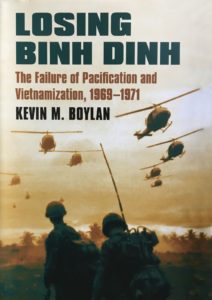Losing Binh Dinh: The Failure of Pacification and Vietnamization, 1969-1971 By Kevin M. Boylan, University Press of Kansas, 201
 Whether the Vietnam War was ultimately winnable has long divided historians. “Revisionists,” unlike their “orthodox” counterparts, insist the war was indeed winnable, and some claim that the war had been won by the early 1970s, only to be squandered by feckless politicians in Washington. Losing Binh Dinh, written by former Defense Department analyst Kevin M. Boylan, challenges the lost victory thesis in this compelling account of the war in a strategically vital South Vietnamese province.
Whether the Vietnam War was ultimately winnable has long divided historians. “Revisionists,” unlike their “orthodox” counterparts, insist the war was indeed winnable, and some claim that the war had been won by the early 1970s, only to be squandered by feckless politicians in Washington. Losing Binh Dinh, written by former Defense Department analyst Kevin M. Boylan, challenges the lost victory thesis in this compelling account of the war in a strategically vital South Vietnamese province.
Boylan’s thoughtful study examines the conflict in Binh Dinh province, primarily through the prism of Operation Washington Green. The fertile, rice-producing province, which abutted the South China Sea and extended west to the rugged Central Highlands, was regarded as the heartland of the Communist insurgency in that region. The U.S. Army’s 173rd Airborne Brigade initiated Washington Green in the restive province in April 1969 to promote “pacification” (a program to push out the Viet Cong through economic development efforts and enhanced security) and to advance President Richard Nixon’s Vietnamization policy of transferring more combat responsibility to South Vietnamese forces.
Dispensing with the large, multibattalion sweeps that had characterized the 1st Cavalry Division’s search-and-destroy operations in Binh Dinh, the 173rd Airborne dispersed across the northern districts of the province in small detachments to improve security and train struggling local militia forces. Washington Green’s planners hoped that with more training, local forces would be able to assume responsibility for village and hamlet security, freeing South Vietnamese regulars to take on the North Vietnamese Army. This, in turn, would allow American troops to stand down and gradually withdraw from the country.
Reluctantly, the wary Sky Soldiers of the 173rd partnered with the militias and pushed into dozens of Communist-dominated hamlets. Within months, the security situation in Binh Dinh’s four northern districts had improved. By the end of the year, 90 percent of the population in the 173rd’s area of operations was living under allied military control. The Nixon administration would tout Washington Green as a successful example of Vietnamization.
The militia forces, however, were ineptly led and dependent on American logistical support. They performed unevenly alongside the Sky Soldiers and in some respects had grown more reliant on American assistance and initiative. Absent the prodding and cajoling of their U.S. advisers, the poorly motivated militiamen appeared unable or unwilling to act. Similar charges were leveled against the province’s civil administration. Washington Green, Boylan astutely observes, was failing—despite the 173rd Airborne’s best efforts.
Nevertheless, Boylan occasionally overreaches. He writes that despite “the growing volume of supplies shipped down the Ho Chi Minh Trail or by sea through the Cambodian port of Sihanoukville, Communist regular military units operating in South Vietnam remained highly dependent on food collected by the [Viet Cong] and transported by civilian porters.” Although it is true that Communist regulars in South Vietnam in the early 1960s relied heavily on the civilian population’s support, the logistical situation had changed in 1965-1966. Thereafter, a number of Communist main force units depended on North Vietnam for their logistical survival.
In the fall of 1969, the North Vietnamese Army returned to Binh Dinh, prompting the 173rd to pull some battalions off pacification duty to counter the new threat. Almost immediately, the Viet Cong challenged the hard-won security gains in the northern districts. That trend continued into 1970. While an argument can be made for a more charitable interpretation of the war nationwide, Boylan demonstrates that the war had not been won by December 1971, when Operation Washington Green officially concluded.
Considerable in scope, Losing Binh Dinh provides additional intellectual grist to the ongoing Revisionist-Orthodox debate.
Published in the August 2017 issue of Vietnam magazine.





